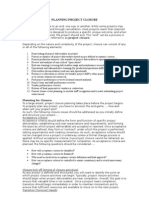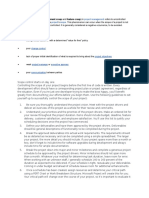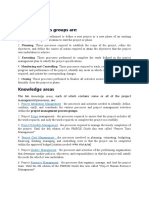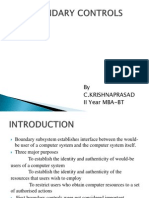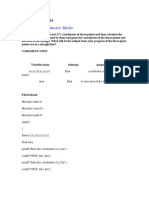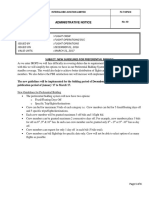Project Management Tools
Uploaded by
rajkamalturns19Project Management Tools
Uploaded by
rajkamalturns19PROJECT MANAGEMENT TOOLS Project management software has the capacity to help plan, organize, and manage resource
pools and develop resource estimates. Depending on the sophistication of the software, it can manage estimation and planning, scheduling, cost control and budget
management, resource
allocation, collaboration
software, communication, decision-making,
quality management and documentation or administration systems. Today, numerous PC-based project management software packages exist, and they are finding their way into almost every type of business. In the early days, however, project management software ran on big mainframe computers and was used only in the large projects. These early systems were limited in their capabilities and, by today's standards, were hard to use.
WHY USE PROJECT MANAGEMENT SOFTWARE?
Some companies estimate an increase in production by as much as 30 percent after implementing a project management system. This means you could potentially accept 30 percent more projects and pull in more revenue using the same resources you have now. If your collection of spreadsheets and limited collaboration tools are becoming burdensome and inefficient, it is time to consider an online project management solution. Most top project management software works alongside your current business solutions, including Outlook, SAP, ERM, CRM, accounting software and Salesforce, either via direct integrations or advanced programming interfaces (APIs). The best online project management services can help PMOs manage multiple projects, from the initial project request to the final invoicing. Nowadays, most of these services also provide mobile tools and modern social networking tools for time entry, expense tracking, status updates and secure team collaboration. The most capable solutions also provide free client interfaces so that your customers can submit requests and view projects' statuses. Global and remote teams can take advantage of alwaysavailable web access, and companies that need to control their own security can install the solution onpremise. Endless, customizable reporting options can help you easily prepare communications for your executives and clients.
PROJECT MANAGEMENT: WHAT TO LOOK FOR When reviewing these products, we considered their basic project management tools as well as their resource management and collaboration tools. This year, we stepped it up a notch and also evaluated the companies in general, because adding a project management solution is often a long-term partnership and it is important that the company has a proven track record of supporting its product and its customers. We asked each company what new features they have added over the past year and what new features are in development. We also considered their relevance, based on the answers to the following questions: Have they created a useful product that caters to market and customer demand? Are they evolving with emergent technologies? Will they answer your phone when you really need them? Will they fly in to train your team in person? The best companies value customer retainment and strive to provide exceptional service. Below are the criteria that we used to evaluate online project management services: THE TRADITIONAL APPROACH A traditional phased approach identifies a sequence of steps to be completed. In the "traditional approach", five developmental components of a project can be distinguished (four stages plus control):
Typical development phases of an engineering project 1. initiation 2. planning and design 3. execution and construction
4. monitoring and controlling systems 5. completion Not all projects will have every stage, as projects can be terminated before they reach completion. Some projects do not follow a structured planning and/or monitoring process. And some projects will go through steps 2, 3 and 4 multiple times. Many industries use variations of these project stages. For example, when working on a brick-and-mortar design and construction, projects will typically progress through stages like pre-planning, conceptual design, schematic design, design development, construction drawings (or contract documents), and construction administration. In software development, this approach is often known as the waterfall model, i.e., one series of tasks after another in linear sequence. In software development many organizations have adapted the Rational Unified Process (RUP) to fit this methodology, although RUP does not require or explicitly recommend this practice. Waterfall development works well for small, well defined projects, but often fails in larger projects of undefined and ambiguous nature. The Cone of Uncertainty explains some of this as the planning made on the initial phase of the project suffers from a high degree of uncertainty. This becomes especially true as software development is often the realization of a new or novel product. In projects where requirements have not been finalized and can change, requirements management is used to develop an accurate and complete definition of the behavior of software that can serve as the basis for software development. While the terms may differ from industry to industry, the actual stages typically follow common steps to problem solving"defining the problem, weighing options, choosing a path, implementation and evaluation." PROJECT MANAGEMENT TOOLS Top online management solutions support traditional project-management ideologies and incorporate emergent technologies. For example, they should be able to easily handle traditional methodologies such as Waterfall, Agile, PRINCE2 and Chain methods and have the ability to create proprietary processes. We also evaluated whether the project management tools can handle all basic functions such as request management, budgeting, issues, risk assessment and
task management. The best products also provide extensive reporting options and easy ways to share those reports with stakeholders and other interested groups. RESOURCE MANAGEMENT
We evaluated the tools available for project managers to manage and allocate resources, including team members, external resources, generic resources, documents and physical assets. In addition, this category includes the tools for tracking expenses and timesheets. We also looked for advanced search tools for filtering resources so that project managers can find resources that are not only available, but are also at the experience level and price that fits projects' requirements. COLLABORATION
Although this comparison focuses on project manager tools, we briefly looked at how team members can interact and what tools there are for clients to monitor projects. Collaboration tools include features such as discussions or streams, social networking type tools, file sharing and announcements. We also looked to see if the services offer free tools for non-paid users, such as report viewing and read-only accounts. EASE OF USE
High adoption rates are directly related to ease of use. If the software is difficult to use, it may not be used, which will directly affect your company's return on investment (ROI). Also, inscrutable project management software may not be used to its fullest capacity. We looked for convenience features such as project templates, customization options, import tools, automated functions and more to determine how easy and convenient each project manager is to use. The service should also provide ample training through webinars, documentation, videos and even one-on-one training to help your team learn how to use the service quickly.
INTEGRATION & PROFESSIONAL SERVICES
Implementing a project management solution is not a casual, one-time purchase; it is a partnership. It is imperative to find a company that will provide the services you require, such as custom integrations, on-site training and direct support options. The best services create customized implementation plans, provide one-on-one management training and connect you with a dedicated account manager (for large contracts). Support should be provided throughout the life of your contract, and the support teams should be dedicated and motivated to help you resolve all issues to your satisfaction. SUMMARY: Clarizen online project management solution is simple to use, easy to integrate and experiences a high adoption rate among mangers and team members. It is equipped to provide accurate, insightful project transparency for project managers and stakeholders via customizable reports. It is ideal for dispersed teams with a variety of account requirements that range from free email-only accounts to time and expense accounts and full enterprise editions.
SUMMARY ON SEMINAR TOPIC: PROJECT MANAGEMENT TOOLS
Submitted by RAJA.R
You might also like
- Monolith Productions Case Study MECN4020 - Systems Management and IntegrationNo ratings yetMonolith Productions Case Study MECN4020 - Systems Management and Integration24 pages
- Session 1 - Week 1 - Introduction To Project ManagementNo ratings yetSession 1 - Week 1 - Introduction To Project Management27 pages
- PMP Chapter 4 Test Project Integration ManagementNo ratings yetPMP Chapter 4 Test Project Integration Management3 pages
- Advanced Techniques in Project Management OverviewNo ratings yetAdvanced Techniques in Project Management Overview9 pages
- Submitted By: Preeti Submitted To: Prof - Tejinder ROLL NO: 18010 Class: Mcom 1St100% (1)Submitted By: Preeti Submitted To: Prof - Tejinder ROLL NO: 18010 Class: Mcom 1St16 pages
- Rita Mulcahy: PM Crash Course ™ For IT ProfessionalsNo ratings yetRita Mulcahy: PM Crash Course ™ For IT Professionals6 pages
- EPLC Project Completion Report Practices GuideNo ratings yetEPLC Project Completion Report Practices Guide5 pages
- Communication Project Management and COVID 19100% (1)Communication Project Management and COVID 1911 pages
- Module 2: Project Management Overview Project Management Overview and DefinitionNo ratings yetModule 2: Project Management Overview Project Management Overview and Definition2 pages
- Project Scope Management: The Project Scope Statement, The WBS and The WBS DictionaryNo ratings yetProject Scope Management: The Project Scope Statement, The WBS and The WBS Dictionary3 pages
- Audit Report - Part 1 New Project Movies and ThrowbacksNo ratings yetAudit Report - Part 1 New Project Movies and Throwbacks9 pages
- Roles and Responsibility of A Project ManagerNo ratings yetRoles and Responsibility of A Project Manager7 pages
- PPM - Programme and Project Management - Report - Donor Reporting Guideline and TemplateNo ratings yetPPM - Programme and Project Management - Report - Donor Reporting Guideline and Template18 pages
- Assignment - PM0011 - Project Planning and Scheduling - Set 2No ratings yetAssignment - PM0011 - Project Planning and Scheduling - Set 211 pages
- Chapter 4 - Project Integration ManagementNo ratings yetChapter 4 - Project Integration Management92 pages
- Project Management L5 Assessment Brief May 2021No ratings yetProject Management L5 Assessment Brief May 20218 pages
- Monitoring & Controlling in Software Project ManagementNo ratings yetMonitoring & Controlling in Software Project Management15 pages
- Intranet Best Practices: What Are The Business Benefits?No ratings yetIntranet Best Practices: What Are The Business Benefits?5 pages
- A Practical Use of Key Success Factors To Improve The Effectiveness of Project ManagementNo ratings yetA Practical Use of Key Success Factors To Improve The Effectiveness of Project Management7 pages
- 14 Determining Project Progress and Results & Finishing The Projects and Realizing The BenefitsNo ratings yet14 Determining Project Progress and Results & Finishing The Projects and Realizing The Benefits41 pages
- A Project Management Information System Serves Five Principal PurposesNo ratings yetA Project Management Information System Serves Five Principal Purposes9 pages
- Next Generation Project Management Systems - A Quality Approach .50% (2)Next Generation Project Management Systems - A Quality Approach .124 pages
- Chapter3 - Defining The Roles of The Project Manager and The Theam100% (1)Chapter3 - Defining The Roles of The Project Manager and The Theam10 pages
- Chapter 12 - Project Implementation-Closure and Evaluation PDFNo ratings yetChapter 12 - Project Implementation-Closure and Evaluation PDF18 pages
- AGILE PROJECT MANAGEMENT: Navigating Complexity with Efficiency and Adaptability (2023 Guide for Beginners)From EverandAGILE PROJECT MANAGEMENT: Navigating Complexity with Efficiency and Adaptability (2023 Guide for Beginners)No ratings yet
- Cost Estimation in Agile Software Development: Utilizing Functional Size Measurement MethodsFrom EverandCost Estimation in Agile Software Development: Utilizing Functional Size Measurement MethodsNo ratings yet
- Seating Arrangement Seating Arrangement 11 - Verbal Reasoning Questions and AnswersNo ratings yetSeating Arrangement Seating Arrangement 11 - Verbal Reasoning Questions and Answers2 pages
- Hockey Cricket Football Agha Khan Cup All-India Women'S Guru NanakchampionshipNo ratings yetHockey Cricket Football Agha Khan Cup All-India Women'S Guru Nanakchampionship3 pages
- CRR Cut To Improve Margins by 1-2bps: EmkayNo ratings yetCRR Cut To Improve Margins by 1-2bps: Emkay3 pages
- Verification - Validation - Characterization Engineer Resume - Hire IT People - We Get IT DoneNo ratings yetVerification - Validation - Characterization Engineer Resume - Hire IT People - We Get IT Done7 pages
- West Hollywood Chamber of Commerce Newsletter Fall 2010No ratings yetWest Hollywood Chamber of Commerce Newsletter Fall 201016 pages
- 5G Wireless Technology Agency by SlidesgoNo ratings yet5G Wireless Technology Agency by Slidesgo40 pages
- Vertex Vx-2100-2200 Series Specsheet 0609 A4No ratings yetVertex Vx-2100-2200 Series Specsheet 0609 A42 pages
- Introduction To Machine Learning With Python A Guide For Beginners in Data Science 9781724417503 1724417509100% (2)Introduction To Machine Learning With Python A Guide For Beginners in Data Science 9781724417503 1724417509176 pages
- MIX-M501MAP Monitor Module: Installation and Maintenance InstructionsNo ratings yetMIX-M501MAP Monitor Module: Installation and Maintenance Instructions1 page
- Understanding Phases of E-Government Project PDFNo ratings yetUnderstanding Phases of E-Government Project PDF6 pages
- C Lab Programs: Tapasya Gutha Gitam Cse B EditNo ratings yetC Lab Programs: Tapasya Gutha Gitam Cse B Edit38 pages
- Smart-UPS Firmware Upgrade Wizard v4.2.1 Technical GuideNo ratings yetSmart-UPS Firmware Upgrade Wizard v4.2.1 Technical Guide11 pages
- Fragmented Contract Management: Challenges, Impacts and SolutionsNo ratings yetFragmented Contract Management: Challenges, Impacts and Solutions22 pages
- Monolith Productions Case Study MECN4020 - Systems Management and IntegrationMonolith Productions Case Study MECN4020 - Systems Management and Integration
- Session 1 - Week 1 - Introduction To Project ManagementSession 1 - Week 1 - Introduction To Project Management
- Advanced Techniques in Project Management OverviewAdvanced Techniques in Project Management Overview
- Submitted By: Preeti Submitted To: Prof - Tejinder ROLL NO: 18010 Class: Mcom 1StSubmitted By: Preeti Submitted To: Prof - Tejinder ROLL NO: 18010 Class: Mcom 1St
- Rita Mulcahy: PM Crash Course ™ For IT ProfessionalsRita Mulcahy: PM Crash Course ™ For IT Professionals
- Module 2: Project Management Overview Project Management Overview and DefinitionModule 2: Project Management Overview Project Management Overview and Definition
- Project Scope Management: The Project Scope Statement, The WBS and The WBS DictionaryProject Scope Management: The Project Scope Statement, The WBS and The WBS Dictionary
- Audit Report - Part 1 New Project Movies and ThrowbacksAudit Report - Part 1 New Project Movies and Throwbacks
- PPM - Programme and Project Management - Report - Donor Reporting Guideline and TemplatePPM - Programme and Project Management - Report - Donor Reporting Guideline and Template
- Assignment - PM0011 - Project Planning and Scheduling - Set 2Assignment - PM0011 - Project Planning and Scheduling - Set 2
- Monitoring & Controlling in Software Project ManagementMonitoring & Controlling in Software Project Management
- Intranet Best Practices: What Are The Business Benefits?Intranet Best Practices: What Are The Business Benefits?
- A Practical Use of Key Success Factors To Improve The Effectiveness of Project ManagementA Practical Use of Key Success Factors To Improve The Effectiveness of Project Management
- 14 Determining Project Progress and Results & Finishing The Projects and Realizing The Benefits14 Determining Project Progress and Results & Finishing The Projects and Realizing The Benefits
- A Project Management Information System Serves Five Principal PurposesA Project Management Information System Serves Five Principal Purposes
- Next Generation Project Management Systems - A Quality Approach .Next Generation Project Management Systems - A Quality Approach .
- Chapter3 - Defining The Roles of The Project Manager and The TheamChapter3 - Defining The Roles of The Project Manager and The Theam
- Chapter 12 - Project Implementation-Closure and Evaluation PDFChapter 12 - Project Implementation-Closure and Evaluation PDF
- Project Management Complete Self-Assessment GuideFrom EverandProject Management Complete Self-Assessment Guide
- AGILE PROJECT MANAGEMENT: Navigating Complexity with Efficiency and Adaptability (2023 Guide for Beginners)From EverandAGILE PROJECT MANAGEMENT: Navigating Complexity with Efficiency and Adaptability (2023 Guide for Beginners)
- Cost Estimation in Agile Software Development: Utilizing Functional Size Measurement MethodsFrom EverandCost Estimation in Agile Software Development: Utilizing Functional Size Measurement Methods
- Seating Arrangement Seating Arrangement 11 - Verbal Reasoning Questions and AnswersSeating Arrangement Seating Arrangement 11 - Verbal Reasoning Questions and Answers
- Hockey Cricket Football Agha Khan Cup All-India Women'S Guru NanakchampionshipHockey Cricket Football Agha Khan Cup All-India Women'S Guru Nanakchampionship
- Verification - Validation - Characterization Engineer Resume - Hire IT People - We Get IT DoneVerification - Validation - Characterization Engineer Resume - Hire IT People - We Get IT Done
- West Hollywood Chamber of Commerce Newsletter Fall 2010West Hollywood Chamber of Commerce Newsletter Fall 2010
- Introduction To Machine Learning With Python A Guide For Beginners in Data Science 9781724417503 1724417509Introduction To Machine Learning With Python A Guide For Beginners in Data Science 9781724417503 1724417509
- MIX-M501MAP Monitor Module: Installation and Maintenance InstructionsMIX-M501MAP Monitor Module: Installation and Maintenance Instructions
- Smart-UPS Firmware Upgrade Wizard v4.2.1 Technical GuideSmart-UPS Firmware Upgrade Wizard v4.2.1 Technical Guide
- Fragmented Contract Management: Challenges, Impacts and SolutionsFragmented Contract Management: Challenges, Impacts and Solutions







